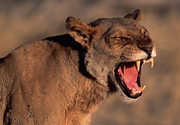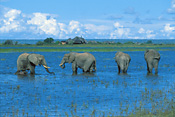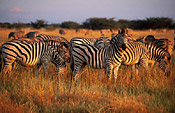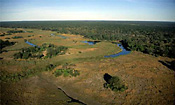Botswana's
Chobe National Park
Safari Information
Summary
 Chobe National Park is one of the
world's last remaining true wilderness areas and one of Africa's greatest
game parks. Chobe is the third largest park in Botswana (after the Central
Kalahari Game Reserve and the remote Gemsbok National
Park in the south-western corner of the country) and covers an area
of 10,698 square kilometres. Chobe however, is unquestionably the most
spectacular and diverse of Botswana's areas, even more so than the celebrated
Okavango Delta. Chobe National Park is one of the
world's last remaining true wilderness areas and one of Africa's greatest
game parks. Chobe is the third largest park in Botswana (after the Central
Kalahari Game Reserve and the remote Gemsbok National
Park in the south-western corner of the country) and covers an area
of 10,698 square kilometres. Chobe however, is unquestionably the most
spectacular and diverse of Botswana's areas, even more so than the celebrated
Okavango Delta.
Chobe National Park is home to huge herds of Elephant, Buffalo, and Burchell's
Zebra and high densities of predators such as Lion, Leopard, Spotted Hyena
and Cheetah. The park is also notable for the presence of more unusual
antelope species like Roan and Sable, Puku, Tsessebe, Eland, Red Lechwe,
Waterbuck, and the rare Chobe Bushbuck. Other more popular species such
as Giraffe, Kudu, Warthog, Wildebeest and Impala also abound. |
History
The Chobe area became popular in
the mid-19th century with European hunters, who flocked to the area to
shoot big game. Prior to this the wildlife had only been hunted by traditional
means for subsistence by the native people. However, the white hunters
introduced firearms to the indigenous people and this soon led to a massive
increase in the killing of wildlife. The locals were encouraged to shoot
far more than they needed in order to barter for European goods like
tobacco,
clothes, blankets and more guns.
Later visitors exploited the timber of the indigenous forests along the
Chobe River. Commercial logging began prior to World War I and then again
from 1944-1955. Teak was the major timber species and these trees still
exist in Chobe, but not along the river. Thus, the lumber industry drastically
altered the vegetation along the Chobe River; however, many today blame
Elephants for this carnage. The lumber mills along the river closed down
in the mid 1950's because there were no more trees remaining.
The Chobe Game Reserve was proclaimed by the colonial Bechuanaland Government
in 1961 to control the widespread hunting and logging in the area. The
park first opened to the public in August 1964 and it was upgraded to
national park status in 1968 after Botswana's independence.
Geography
Chobe can be divided into four main
regions: The Chobe riverfront which supports the greatest concentration
of wildlife and outstanding birding, the Savuti marsh which also offers
prime habitat, the Linyanti swamps, and dry hinterland in between them
all.
 The Chobe Riverfront: The riverfront is well known for its vast herds of Elephant and Buffalo
that concentrate to drink from the river in the dry season. This area
is perhaps the most frequented by visitors and its proximity to the Victoria
Falls makes it an even more popular destination. This area therefore has
a wide variety of tourist facilities ranging from posh five-star lodges
to fully catered safari camps and do-it-yourself campgrounds. The Chobe Riverfront: The riverfront is well known for its vast herds of Elephant and Buffalo
that concentrate to drink from the river in the dry season. This area
is perhaps the most frequented by visitors and its proximity to the Victoria
Falls makes it an even more popular destination. This area therefore has
a wide variety of tourist facilities ranging from posh five-star lodges
to fully catered safari camps and do-it-yourself campgrounds.
Most of the wildlife activity occurs along the banks of the river - especially
during the drier winter months when animals must congregate at the river
to quench their thirst. Game viewing here is by vehicle along the river
or by boat on the river. Both offer excellent game viewing, especially
of the large herds of Elephant and Buffalo. Because of the large number
of tourists in this area, the density of vehicles can become a bit high
and this can detract from the wilderness experience. Still, for game viewing,
especially large herds, the Chobe riverfront is the place to go in Botswana.
Birding enthusiasts will also find the riverfront a fantastic destination,
especially during Botswana's summer months when the migratory species
return. The Chobe River offers great birding and within the park there
are over 400 different species. Occasionally, Carmine Bee-eaters can be
seen building their nests in the sand banks of the river.
|
 The
Savuti Marsh: The Marsh area is well known for its
coverage in a number of well known wildlife documentaries, especially
the National Geographic films by Dereck and Beverly Joubert. Situated
on the bed of a once-huge Paleo super-lake, Savuti is comprised of rich
grasslands, savannah woodland and a large variety of trees and vegetation. The
Savuti Marsh: The Marsh area is well known for its
coverage in a number of well known wildlife documentaries, especially
the National Geographic films by Dereck and Beverly Joubert. Situated
on the bed of a once-huge Paleo super-lake, Savuti is comprised of rich
grasslands, savannah woodland and a large variety of trees and vegetation.
In
years when the Savuti channel has flowed (see more on the channel in
our Linyanti page), the grasslands
of the Savuti Marsh were perhaps the greatest wildlife paradise - especially
for big game and predators - in all of Africa. The channel is currently
dry, but it could flow again at any time based an minor tectonic movements
far beneath the Kalahari sands upon with it exists. Still, each year,
with the coming of the summer rains (December through March), the Savuti
marsh transforms back to at least some of the splendor it has known in
prior years when the channel was flowing. |
Savuti has three distinct seasons: the wet (and hot) rainy season, the
early dry season - when there is still water available in the seasonal
pans, and the late dry season, which extends through the winter months
until the onset of summer and the rains. During the dry period, when
Savuti
is parched, the only available water is from the man-made waterholes
(which pump water from below ground). After the rains finally arrive
in late
November, the area is transformed almost overnight into a lush grassland
and within days, the herds of herbivores begin to arrive - Zebras, Wildebeest
and Buffalo appear in the thousands.
The Zebra and Wildebeest pass through Savuti on their annual migration
south from the Linyanti marshes. The herds remain in Savuti for several
weeks to have their young and feed on the new grasses before moving further
on into the Mababe Depression. These same herds then reappear in Savuti
later in the season, around March-April, when they are again passing through
on their long migration northwards back to their dry season range along
the Chobe and Linyanti Rivers. This Zebra-Wildebeest migration is on of
nature's great spectacles and it provides a bounty for the predators which
depend upon them to survive.
Although game viewing in the Savuti marsh is an all-year activity, during
the peak rains the animals are scattered over a wide area and more difficult
to see, especially when the grasses grow long and tall. The wet season
is however a fabulous time for birding as the migrant waders and waterbirds
appear to take advantage of the new water in the pans. Throughout the
remainder of the year, the area is full of wildlife with a huge variety
of species. Giraffe, Kudu, Impala, Tsessebe are always present. The wide-open
plains attract Cheetah and the various rocky areas around Savuti provide
excellent habitat for Leopard and the agile Klipspringer antelope.
Game-viewing conditions are generally better in the dry season, with its
shorter grasses, thinned-out vegetation and the animals being more restricted
as to their water sources. Also, the days are cooler. When dry, the Savuti
landscape, with its long-dead, skeletal trees against the deep blue sky
provides for excellent photography, particularly when the plains game
begins to move back towards the woodlands at dusk and stir up clouds of
dust into the red sunset sky.
Tourist facilities in the marsh include several upscale safari camps,
as well as public campsites.
 The Linyanti Swamps: The
western section of Chobe, known as Linyanti, along the Linyanti and Chobe
Rivers and its surrounding swamps,
is one of the most remote and inaccessible parts of Botswana. However,
guests at the private safari camps in the Linyanti are able to fly in
to private airstrips and experience this amazing wilderness area. For
a detailed write up on the Linyanti area, please see our Linyanti page. The Linyanti Swamps: The
western section of Chobe, known as Linyanti, along the Linyanti and Chobe
Rivers and its surrounding swamps,
is one of the most remote and inaccessible parts of Botswana. However,
guests at the private safari camps in the Linyanti are able to fly in
to private airstrips and experience this amazing wilderness area. For
a detailed write up on the Linyanti area, please see our Linyanti page. |
(Portions of the information above were
excerpted from Daryl and Sharna Balfours' excellent book, Chobe -
Africa's Untamed Wilderness)
Which time of year
is best to visit Chobe?
The best time for visiting
the riverfront area is in the dry winter months from June to October,
when the dry inland forces the animals to congregate around the rivers
and permanent water sources. Given that this area is such a short distance
from the Zimbabwe border and Victoria Falls, it is ideal to combine with
a short visit to the Falls.
The Savute marsh becomes home to
thousands of Zebra when they migrate from the Mababe Depression round
about May and then return in November. The Savute region is also well
known for its Lion population and given the high concentration of plains
game in this area, the entire predator population is high.
 Top
Top  Return to Map of
Chobe / Linyanti
Return to Map of
Chobe / Linyanti
 Water
/ Land Activity Table for Botswana camps: Water/Land
Botswana Water
/ Land Activity Table for Botswana camps: Water/Land
Botswana
 Flying
Times between Botswana camps: Fly
Times Botswana Flying
Times between Botswana camps: Fly
Times Botswana
 For further information about the Linyanti Wildlife Reserve, click More
Linyanti
For further information about the Linyanti Wildlife Reserve, click More
Linyanti
 For further information about Botswana, click More
Botswana
For further information about Botswana, click More
Botswana
|